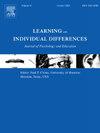早期汉英读写学习者在单词拼写中语音意识的跨语言共享:三波交叉滞后面板分析
IF 9
1区 心理学
Q1 PSYCHOLOGY, EDUCATIONAL
引用次数: 0
摘要
本研究探讨了汉语和英语语音意识在超音段和音段水平上与单词拼写的纵向跨语言关联。从三年级结束到四年级结束,每六个月对161名中英双语儿童进行一次随访。交叉滞后面板模型揭示了三年级末至四年级中期分词习得与两种语言单词拼写之间的相互跨语言关系。然而,这种从第一语言(汉语)到第二语言(英语)方向上的互惠只在英语假单词拼写中观察到,而在真实单词拼写中没有观察到。到四年级结束时,这种互惠性消失了,只剩下从汉语分词PA到英语假词拼写的单向预测,并延伸到英语真词拼写。研究结果表明,语段辅助发音与双语单词拼写之间的跨语言关系是动态变化的,并强调语段辅助发音在双语拼写发展中是一种共享的语言资源。教育相关性声明中英双语儿童双语习得的最新进展表明,除了片段特征外,超片段语音意识在双语习得中也起着重要作用。本研究探讨了语音意识在超音段和音段两个层面上对汉英双语儿童单词拼写发展的双向跨语言影响。结果表明,PA存在双向跨语言迁移,PA与单词拼写之间存在复杂的发展相互作用,并且片段PA在预测双语单词拼写方面具有一致的粒度效应。它从发展的角度阐明了双语理论,并告知与跨语言拼写收益相关的音韵学的具体和普遍情况。本文还为中英读写学习者的双语拼写教学提供了教学启示。本文章由计算机程序翻译,如有差异,请以英文原文为准。
Cross-linguistic sharing of phonological awareness in word spelling among early Chinese-English literacy learners: A three-wave cross-lagged panel analysis
This study examines the longitudinal cross-linguistic associations of phonological awareness (PA) at suprasegmental and segmental levels with word spelling in Chinese and English. An initial sample of 161 Chinese-English bilingual children was followed up every six months from the end of grade 3 to the end of grade 4. Cross-lagged panel models revealed reciprocal cross-linguistic relations between segmental PA and word spelling in both languages from the end of grade 3 to halfway grade 4. However, this reciprocity in the L1 (Chinese)-to-L2 (English) direction was observed only for English pseudoword spelling, not real word spelling. By the end of grade 4, this reciprocity vanished, leaving only a unidirectional prediction from Chinese segmental PA to English pseudoword spelling, which also extended to English real word spelling. The findings illustrate dynamically changing cross-linguistic relations between PA and bilingual word spelling and underscore segmental PA as a shared linguistic resource in bilingual spelling development.
Educational relevance statement
Recent advances in Chinese-English bilingual children’s biliteracy acquisition have implicated an important role of suprasegmental phonological awareness, in addition to segmental features, in biliteracy acquisition. This study explores the bidirectional cross-linguistic influence of phonological awareness (PA) at both suprasegmental and segmental levels on word spelling development in Chinese-English bilingual children. Results indicate a bi-directional cross-linguistic transfer of PA and complex developmental interplay between PA and word spelling, together with a consistent grain size effect of segmental PA in predicting bilingual word spelling. It sheds light on the biliteracy theoretical accounts from a developmental lens and informs specifics and universals of phonology in relation to cross-linguistic gains of spelling. It also provides pedagogical implications for bilingual spelling instruction for Chinese-English literacy learners.
求助全文
通过发布文献求助,成功后即可免费获取论文全文。
去求助
来源期刊

Learning and Individual Differences
PSYCHOLOGY, EDUCATIONAL-
CiteScore
6.60
自引率
2.80%
发文量
86
期刊介绍:
Learning and Individual Differences is a research journal devoted to publishing articles of individual differences as they relate to learning within an educational context. The Journal focuses on original empirical studies of high theoretical and methodological rigor that that make a substantial scientific contribution. Learning and Individual Differences publishes original research. Manuscripts should be no longer than 7500 words of primary text (not including tables, figures, references).
 求助内容:
求助内容: 应助结果提醒方式:
应助结果提醒方式:


